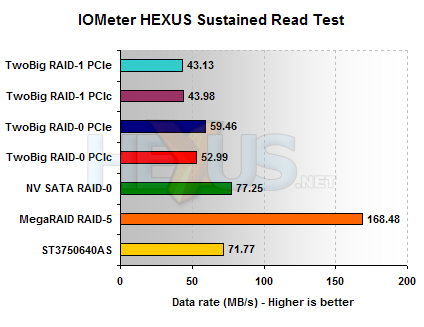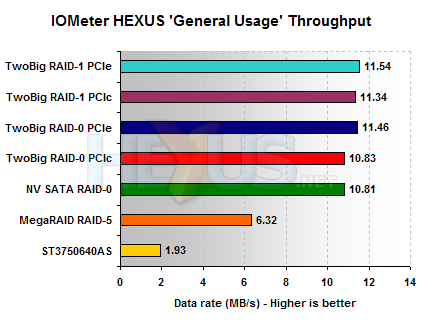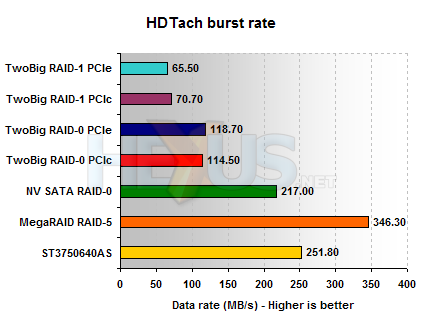Performance: IOMeter and HDTach
IOMeter

Two Big RAID-0 is distinctly faster than RAID-1, but not double. In RAID-0, PCIe seems to have an advantage, but again it's not massive. Still, 60MB/s isn't bad at all. It doesn't quite compare to four disk RAID-5, nor would we expect it to. Note how good the 750GB, perpendicular storage Seagate drive is at reading data. Wooosh!

Converse to our NVIDIA RAID-0 tests with a pair of 250GB SATA drives, where read and write speeds came out roughly the same, it seems Two Big likes RAID-0 writing than it does reading (with our IOMeter configuration at least). There's barely any difference between PCIe and PCIc. The difference between RAID-0 and RAID-1 is more like what we'd expect to see. The MegaRAID was making a cup of tea when we ran these benchmarks...

Simulating read/writes that are a bit more random and user-like, Two Big scores well once again. Our general usage test comprises of 66% reads, and uses smaller transfer sizes than our sustained tests. RAID-0 and RAID-1 performance differences on the Two Big appear to be negated in such scenarios. The two Hitachi disk drives, coupled with TwoBig's RAID controller, beat off a pair of Seagates on NVRAID-0, even when mirroring. Again, little difference between PCIe and PCIc.
Looking back at our Thecus N2050 results, LaCie's Two Big looks to perform roughly on a par with it, although it's impossible to say for sure due to the differing test strategies. They're definitely in the same ballpark, though.
HDTach
If we're going to see a PCIe/PCIc performance difference anywhere, it'll be in HDTach's burst test, simply because of the extra bandwidth available for bursting.

Guess we were wrong there, then. In fact, in RAID-1 Two Big contradicts our beliefs. Again, the difference isn't large. RAID-0 is capable of higher burst speeds, regardless of the interface to which the SATA controller is married. Eight lanes of PCIe give the MegaRAID and its disks a mouthwatering amount of burstiness. NVIDIA's SATA ports reside on the nForce 4 northbridge and so also have ample bandwidth.
We'd expect a little more from TwoBig's burst results if the SATA cards were the limitation, so perhaps the Two Big itself is holding up the data bursts?









